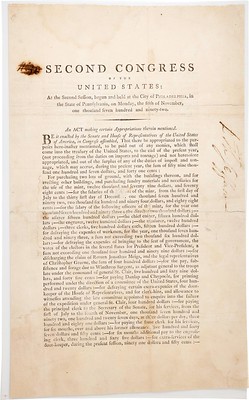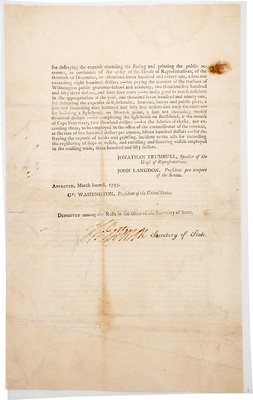
PREV ARTICLE
NEXT ARTICLE
FULL ISSUE
PREV FULL ISSUE
1793 MINT APPROPRIATION ACT OFFEREDStack's Bowers is offering a great piece of early U.S. numismatic ephemera in their August 2024 sale. Here's their description of an important founding document - the March 2, 1793 law appropriating funds for the purchase of the land and buildings that would become the Philadelphia Mint, signed by Thomas Jefferson. -Editor Important Founding Document for the First United States Mint Boldly Autographed by Thomas Jefferson Act of March 2, 1793 Act of March 2, 1793 signed by Thomas Jefferson as Secretary of State. "An Act Making Certain Appropriations Therein Mentioned." Laid paper, printed with manuscript autograph and docketing. 12.4 inches x 7.7 inches. An original signed printing of one of the U.S. Mint's most important foundational documents, the appropriations bill authorizing the purchase of the land and buildings that became the first United States Mint, in addition to the salaries for its first employees. Approved by Congress on November 5, 1792 and enacted into law by President George Washington on March 2, 1793, this bill's first order of business is the earliest commitment to building a functioning Federal Mint. While earlier bills authorized the Mint (most notably the Mint Act of April 2, 1792), this act wrote the checks that made the Mint a reality. After a boilerplate first paragraph, this act gets down to the task at hand: For purchasing two lots of ground, with the buildings thereon, and for erecting other buildings, and purchasing sundry materials and necessaries for the use of the mint, twelve thousand and seventy-nine dollars and seventy-eight cents. It continues with a list of the Mint's founding positions and provides for payment of their salaries, retroactive to July 1792, the previous year. For the salaries of the officers of the mint, from the first day of July to the thirty first day of December, one thousand seven hundred and ninety two, two thousand six hundred and ninety four dollars, and eighty eight cents. And proceeds to provide for their salaries in 1793, their first full year of employment: For the salary of the following officers of the mint, for the year one thousand seven hundred and ninety three: the director two thousand dollars; the assayer fifteen hundred dollars; the chief coiner, fifteen hundred dollars; the engraver, twelve hundred dollars; the treasurer, twelve hundred dollars; three clerks, five hundred dollars each, fifteen hundred dollars; for defraying the expenses of workmen, for the year, one thousand seven hundred and ninety three, a sum not exceeding two thousand six hundred dollars. The act continues with other appropriations, including the cost of delivering Presidential votes to the seat of government. This copy is signed by Thomas Jefferson as Secretary of State, likely because it was distributed (perhaps to a member of Congress or another member of the government) from his office. This is a separate one page offprint that stands on its own, as issued; it is not a page removed from a book of proceedings. Another individual has inked Jefferson's name at the broad right margin in the era, an official docketing that indicates from whom the document came. A later individual, during this document's life as collectible, has bracketed the Mint-related content at left margin in pencil and rewritten the word "officers" that was largely missing from the text. Several folds are seen, some producing areas of eternal weakness or closed splits. The horizontal folds are heaviest, producing a split at the right margin, though a vertical fold creates a central lacuna and affects the H of Th. in Jefferson's autograph. Some toning is seen, but the overall visual appeal is excellent. The top margin is uneven, as issued. An ink notation left of SECOND has been struck out, leaving a stain on the verso. Signed in hand by Jefferson, this document is the only copy we've encountered. We handled it nearly 20 years ago, in 2006, when it brought $41,400. While the Jefferson autograph is valuable, the most important aspect of this document is its status as a witness to history: printed as the human and physical resources of the First U.S. Mint were being assembled, during the exact time the nascent mint was involved in the coining of the 1793 Chain cents. This document bridges the gap from the patterns and plans of 1792 to their full manifestation in 1793. This would be a landmark addition to any advanced numismatic collection. Provenance: From our sale of the Old West and Franklinton Collections, August 2006, lot 16.
To read the complete article, see:
Wayne Homren, Editor The Numismatic Bibliomania Society is a non-profit organization promoting numismatic literature. See our web site at coinbooks.org. To submit items for publication in The E-Sylum, write to the Editor at this address: whomren@gmail.com To subscribe go to: https://my.binhost.com/lists/listinfo/esylum All Rights Reserved. NBS Home Page Contact the NBS webmaster 
|


